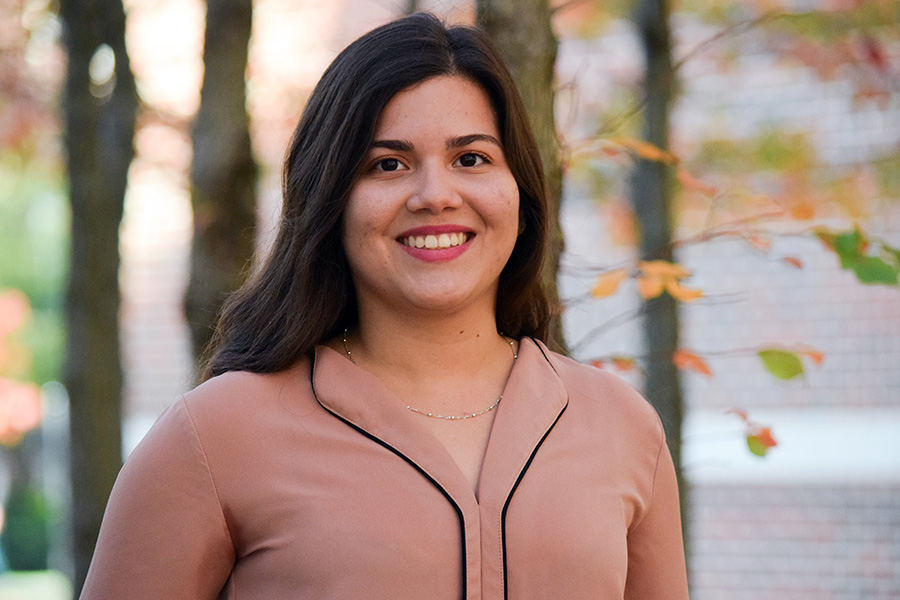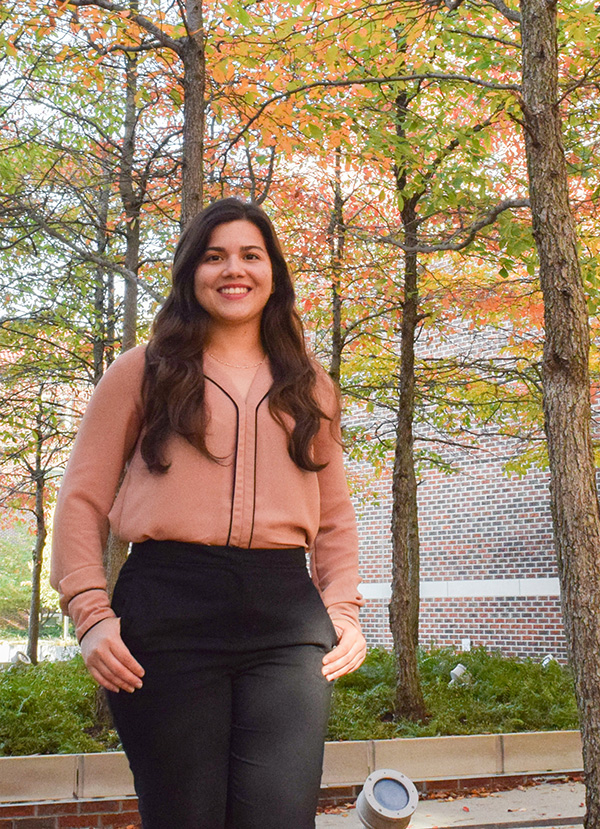Doctoral candidate Stefannie Morales Jiménez studies greener hypergolic propellants with NASA fellowship
Earlier this year, and just three months into her doctoral research at Purdue, Stefannie Morales Jiménez was awarded a NASA Space Technology Graduate Research Opportunities (NSTGRO) fellowship. She is one of just 49 people to earn that fellowship this year.
She applied for this prestigious opportunity while still an undergrad at University of Puerto Rico Mayagüez (UPRM). The funding supports her Purdue research into green hypergolic propellants by covering tuition, conference and travel expenses, supplies and a stipend for up to four years.
Below, Morales Jiménez talks about what motivates her to find alternative hypergolic propellants, the person who inspired her to keep pursuing her work in aerospace, and what it means to her to be a Hispanic woman in this field.
How long have you been at Purdue, and where did you earn your previous degrees?
I joined Purdue University in early January of this year. I completed my undergraduate career at the University of Puerto Rico Mayagüez (UPRM) Campus, from which I obtained a Bachelors in Science in chemical engineering.
As I contemplated my options for joining graduate school, I decided that a direct Ph.D. (D-PhD) program in Aeronautics & Astronautics focused in propulsion was the best fit for my academic and research objectives. As part of this program, I will be completing my masters degree along the way while I conduct research under Dr. Timotheé Pourpoint in the Hypergolic Propellants Laboratory located at the Maurice J. Zucrow Laboratories.
As part of my fellowship responsibilities and benefits, I will be conducting part of my research in a NASA center each summer while I am in the program.
Was there a particular person that inspired you to pursue work in aerospace?
As I was completing my undergraduate career, I think I did not have enough exposure about women working in the aerospace sector. Nonetheless, someone who I heard and read about who really changed my perception about my potential to excel in this field was Dr. Marla Pérez-Davis, former director of NASA Glenn Research Center. I identify with her because she was also born and raised in Puerto Rico and she even has the same undergraduate career as me, chemical engineering.
I doubted myself many times about pursuing this path because I felt in disadvantage and thought my undergraduate background would hinder the possibility of me finding a graduate school offer in aerospace engineering.
But as Dr. Pérez-Davis made the difficult possible, I was determined to create and find my own opportunity. Like she said, “you can be whatever you want to be”, and I wanted to be an aerospace engineer just like her.
I find her inspirational because she accomplished a position of recognition and power and did what nobody had ever done before: She became the first Puerto Rican woman to lead any NASA Center. All of her accomplishments and values of education and independence resonate in me and I want to follow her steps and continue rewriting history to make space exploration more balanced and accessible.
Why did you choose Purdue for your doctorate?
I chose Purdue University because of the drive, passion, and collaboration that I sensed and witnessed at Zucrow when I came to visit back in August 2021. The Gambaro Graduate Program of Aeronautics & Astronautics was the ideal choice since the research facilities and resources as well as the academic offer could meet my interest in investigating novel propellant combinations, while offering me flexibility to take multiple courses to set a strong foundation in my major area, propulsion.
In particular, the Hypergolic Propellants Laboratory aligned with my ambition of creating “green” propellants through focused research, design, and development of cutting-edge technologies. I was fortunate enough that Dr. Pourpoint was interested in bringing in students with backgrounds related to chemistry like me, and we found a mutual interest in developing the proposed fellowship work. Purdue and my current advisor showed me that here I have the best-in-class opportunities and partnerships needed to successfully conduct work in chemical propulsion.
How did you feel when you heard that you’d earned the NSTGRO fellowship?
Applicants were supposed to be notified of the award selection the first week of April. I was already midway the second week of April conducting some experiments when I saw a message from my advisor. He wanted me to call him ASAP. I was already wondering what could it be but I was suspecting it had to be about the fellowship.
I called him and he told me “Congratulations you were awarded the NASA fellowship” and I was just thunderstruck, I could not believe it! I felt blood rushing through my face because of the excitement, the joy. I was so happy and I smiled so much that even my cheeks started to hurt.
Afterwards all I could think about was sharing this amazing news with my family and friends. “This is one of the best, if not THE best fellowship in Aerospace Engineering,” my advisor said while he was recognizing my achievement with the laboratory group, I was so overjoyed!
How has your Hispanic heritage affected where you are now?
All my family is from Puerto Rico, and has lived in the island. We all are US citizens, so we are not considered immigrants. Due to this particular political situation, Puerto Rico has been strongly influenced by the United States culture, including the language.
On the island you can hear a lot of “Spanglish,” which is a combination between Spanish and English used day to day. The exposure to English that I had while I was growing up and during my formative career enhanced my opportunities of working outside the island during different semesters. All these experiences served to take me where I am standing today.

What problems do you hope to address with your research?
I’m focused on finding the next generation of liquid hypergolic fuels (i.e., fuels that do not need an ignition source to combust) that meet or surpass the performance of the state-of-the-art while providing properties that are less toxic for handling, storage, and operation. My work targets chemical-propelled payload capabilities that include small spacecraft missions, like CubeSats orbiting the Earth and beyond, that will be so needed in this new age of space exploration.
The specific use I am hoping to address is the need to replace very toxic, corrosive, and potentially carcinogenic fuels used nowadays. These properties impose the need for more rigorous handling procedures and safety precautions that incur higher costs associated with the lifecycle, starting with the production and ending with the fueling stage. The safety and more recently supply concerns for current fuels being used drove my interest in pursuing the growth of alternative propellants.
Why is this an important topic for you?
I aim to be in the next generation of scientists that can tackle the current space travel challenges related to propulsion and accelerate future missions. Some of these challenges are associated with the toxic nature of many rocket propellants. This motivated me to merge my passion for propulsion with environmental applications.
Previous research revealed the need for safer and less toxic storable propellants for more capable and high-performing small spacecraft. By working in this field, I would be supporting the next generation of missions to the Moon and Mars by enabling the integration of miniaturized instrumentation with more efficient propulsion systems.
It is meaningful for you to be a Hispanic woman in aerospace engineering?
I definitely feel that it is meaningful. Since I was living in Puerto Rico, I noticed the absence of Hispanic women in the field, but I thought it was just me being far away from the aerospace hotspots to get the real picture.
But I was wrong, it is actually the sad reality. All the time I have been living in the USA and particularly engaging in the aerospace engineering community, I have confirmed that it is a field dominated by white males in terms of talent and costumers where the participation of women and even more, Hispanic, is very scarce. Every time I get into a classroom or even in my own laboratory, I see the disparity.
I feel like my success is also a responsibility to show other minority groups that they can also achieve what I have, and that together we can balance the workforce. I want to challenge negative workplace culture and lead women into leadership positions to foster diversity and inclusion.
I do not come from money nor from an easy life. Everything I have accomplished is because I strived for it amidst the doubts and the fear of not being sufficiently prepared.
Where do you hope your career will take you next?
I hope that my graduate academic preparation will allow me to obtain a research scientist position at a governmental agency like NASA or a privately owned aerospace company. I am aiming to grow my professional portfolio by focusing on the characterization of combustion kinetics of novel propellant combinations through experimental analysis. This would place me in a favorable position to work in the future challenges for enabling more cost-effective and efficient spaceflight missions.
More importantly, it will prepare me to accomplish my long-term career objective of joining the academic faculty at UPRM. I wish to bring this propulsion knowledge and serve as an advocate to create the first aerospace engineering undergraduate program on the island. My vision is to accelerate the creation of affiliations and facilities dedicated to combustion and propulsion research programs that are accessible to underrepresented communities. I want to expand the visibility of this sector on the island.
Photos and story edits by Alan Cesar

